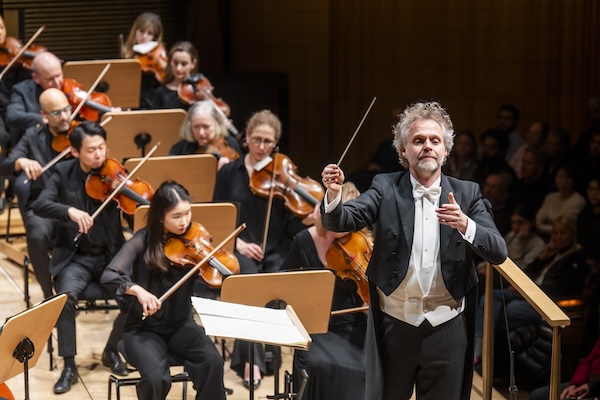Neuwirth premiere disappoints while Søndergård debut impresses with Philharmonic

Thomas Søndergård made his debut with the New York Philharmonic on Thursday evening in a concert of music which was as kaleidoscopic in sound and textures, as it was at times challenging. Throughout, the Danish conductor demonstrated his meticulous attention to detail, as well as his ability to convey the spiritual and emotional depths that he finds in music.
Søndergård, who began his career as a timpanist, is the newly appointed music director of the Minnesota Orchestra. He is also the music director of the Royal Scottish National Orchestra, a post he has held since 2018.
The first work on the program was D’un matin de printemps by Lili Boulanger, sister of the famed composer, conductor and pedagogue Nadia Boulanger. This was one of the last orchestral works which Lili Boulanger completed prior to her death at the age of 24 in 1918.
Søndergård illuminated Lili Boulanger’s impressionistic depiction of a delightful spring morning with the most delicate of musical brush stokes and shimmering musical colors. There was a playfulness in his approach to the piece that was likewise evident in the litheness and fluidity of his movements.
Olga Neuwirth’s Keyframes for a Hippogriff — Musical Calligrams in memoriam Hester Diamond was commissioned by the NY Phil as part of Project 19. This is a multi-season initiative to commission and premiere 19 new works by 19 women composers to commemorate the centennial of the ratification of the 19th Amendment, which established the right to vote for American women in 1919.
Keyframes for a Hippogriff is scored for orchestra, countertenor, and children’s chorus. In addition to a massive percussion session, the orchestral forces include two synthesizers and an electric guitar tuned above the orchestra. The piece is dedicated to the late Hester Diamond, the prominent American art collector who was a friend of the composer.
For the text, Neuwirth pieced together a narrative from fragments of writings from authors ranging from Aristo, William Blake, Emily Dickinson, Friedrich Nietzsche, Walt Whitman, graffiti artists, and herself. Neuwirth wove the words into a dialogue between a countertenor expressing the lack of purpose and isolation of the individual in a dystopian world and a children’s chorus expressing hope for the future.
Neuwirth is a self-styled iconoclast whose works transcend classification and genre. She also comes with a political agenda, describing Keyframes for a Hippogriff as giving voice to “resistance against a ruinous public order that is being damaged by the self-interest of government and industry.” If Neuwirth’s almost impenetrable soundscape wasn’t enough weight for this challenging piece to carry, the message all but sank it.
The live acoustic of Geffen Hall did the work no favors. Throughout the evening, the woodwinds were particularly bright and present. That added charm and excitement to the Boulanger, but in Keyframes for a Hippogriff it resulted into a battle of woodwinds and electronic sound versus the human voice which proved a barrier to comprehension and enjoyment.
The issue rested not so much to do with balance, for Neuwirth cleared the musical decks so to speak when either countertenor or chorus sang, but rather with the jarring juxtaposition of sounds. Countertenor Andrew Watts gave a bravura performance and could always be heard—a microphone in front of him and the generally high-flying tessitura assured to that.
The Brooklyn Youth Chorus, superbly prepared by Dianne Berkun Menaker, sang with confidence and enthusiasm. They too could always be heard and their excellent diction did commendable service to the text. In the fray of this musical battle, these young choristers did indeed provide the innocence and hope which Neuwirth aspired for them to impart.
In contrast to Keyframes for a Hippogriff, Prokofiev’s Fifth Symphony emerged as a model of classical restraint and form. Søndergård’s rhythmically precise reading of the score was in keeping with the composer’s “less is more” approach to music.
Søndergård also imposed a leanness to the orchestra’s sound, which served to emphasize the symphony’s more lyrical passages and illuminate its structure. Here too, however, the woodwinds were particularly present, but they emerged as heroic rather than combatants in a titanic and seemingly futile struggle as in the Neuwirth.
The long first movement was notable for the line and beauty with which the strings played Prokofiev’s melodies. After a stirring repetition of the main theme by the trumpets, the movement concluded with an intense grandeur.
Søndergård’s taut approach to rhythm and tempo resulted in a dizzying account of the scherzo, interrupted only by woodwinds and brasses playing a lyrical melody. The playing of Benjamin Adler, the NY Phil’s new associate principal clarinetist, instilled the third movement with a haunting beauty, as did the darkly luminous sound produced by the strings.
The finale unfolded in equal parts bittersweet lyricism and an incessant build up of tension, leavened only by the frolicking dancelike passages. It ended with slashes of sound that propelled the music to greater heights of frenzy released in a final, thrilling, triumphant clap of sound.
The program will be repeated 8 p.m. Friday and Saturday. nyphil.org